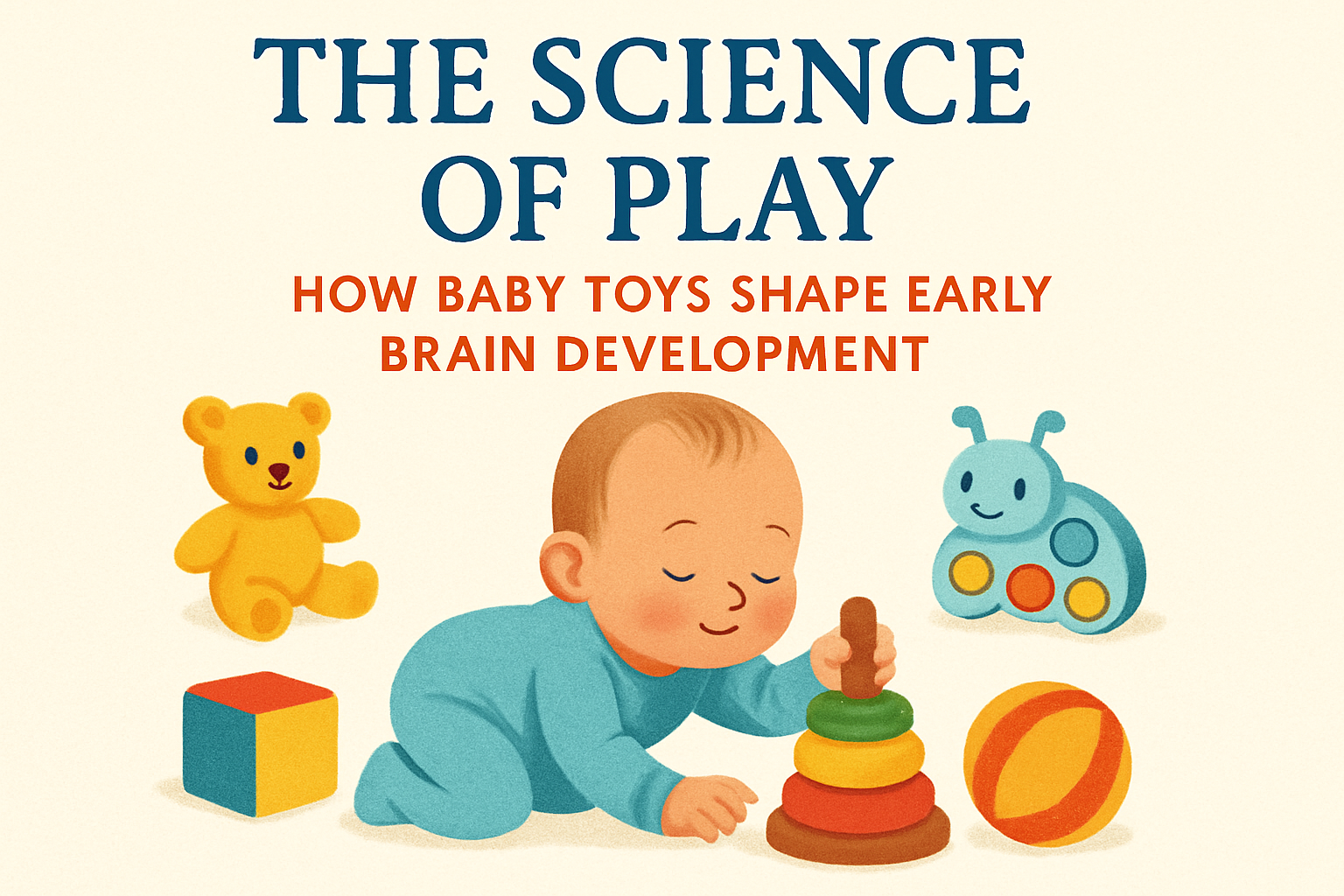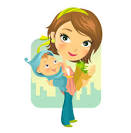The Science of Play reveals that every time a baby reaches for a toy, shakes a rattle, or explores a textured surface, remarkable changes are happening in their developing brain. The early years of life represent a critical window for baby brain development, and the toys we choose for our infants play a far more significant role than simply keeping them entertained. Recent neuroscience research has revealed fascinating insights into how the Science of Play with carefully selected baby toys can stimulate sensory pathways, strengthen motor skills, and lay the foundation for cognitive growth. Understanding the Science of Play and baby brain development empowers parents to make informed choices that support their child’s developmental journey from the very beginning.
The Science of Play and Baby Brain Development
During the first three years of life, a baby’s brain forms more than one million neural connections every second. This extraordinary period of neuroplasticity means that environmental stimuli—including interactions with toys—directly influence brain architecture. When an infant manipulates a toy, multiple brain regions activate simultaneously: the visual cortex processes colors and shapes, the motor cortex coordinates hand movements, the somatosensory cortex interprets textures, and the prefrontal cortex begins developing problem-solving capabilities.
Research published in developmental psychology journals demonstrates that the Science of Play through multisensory stimulation strengthens synaptic connections crucial for baby brain development. Toys that engage multiple senses simultaneously—such as a rattle that produces sound, has varied textures, and displays contrasting colors—create richer neural networks than single-sensory experiences. The repetition inherent in infant play (such as repeatedly dropping and retrieving an object) isn’t mindless behavior; it’s the brain’s way of reinforcing neural pathways through practice, illustrating how the Science of Play supports baby brain development.
The concept of “serve and return” interaction is particularly crucial. When a baby acts on a toy and receives immediate feedback—a button pressed produces a sound, a wheel turned makes an object move—the brain learns cause-and-effect relationships. This interactive quality transforms a simple toy into a powerful learning tool that builds the foundation for logical thinking and executive function.
How the Science of Play Supports Baby Brain Development Through Toys
Sensory Stimulation Toys
Toys designed to engage the senses provide essential input for brain development:
Visual Development: High-contrast toys (especially black and white patterns for newborns) help developing visual systems learn to focus and track objects. As vision matures, toys with bright, primary colors support color discrimination and visual memory.
Auditory Processing: Rattles, musical toys, and crinkle materials expose infants to various sound patterns, frequencies, and volumes. This auditory variety helps the brain differentiate sounds—a precursor to language development.
Tactile Exploration: Toys with diverse textures (soft, bumpy, smooth, ridged) stimulate touch receptors and help babies develop tactile discrimination. This sensory input is crucial for fine motor control and body awareness.
Motor Development Toys
Physical manipulation of toys builds both gross and fine motor skills:
Grasping and Manipulation: Toys designed for little hands—rings, soft blocks, textured balls—encourage reaching, grasping, and hand-eye coordination. These actions strengthen the neural pathways controlling voluntary movement.
Cause-and-Effect Toys: Activity centers, pop-up toys, and simple mechanisms teach babies that their actions have consequences, fostering both motor skills and cognitive understanding.
Movement Encouragement: Play gyms, push toys, and balls that roll away motivate babies to develop gross motor skills like reaching, rolling, crawling, and eventually walking.
Cognitive and Problem-Solving Toys
As babies grow, toys that challenge their emerging cognitive abilities become increasingly valuable:
Shape Sorters and Stacking Toys: These classics teach spatial relationships, problem-solving, and hand-eye coordination while introducing basic concepts of size, shape, and order.
Nesting and Container Toys: Placing objects inside containers and dumping them out helps babies understand object permanence, spatial relationships, and volume concepts.
Simple Puzzles: Age-appropriate puzzles with large pieces build visual-spatial skills, pattern recognition, and persistence.
Practical Recommendations for Parents
Age-Appropriate Selection Guidelines
0-3 Months: Focus on high-contrast visual stimuli, gentle sounds, and safe items for tactile exploration. Mobiles, soft rattles, and textured blankets are ideal.
3-6 Months: Introduce toys that encourage reaching and grasping. Soft blocks, teething toys, and activity gyms support emerging motor skills.
6-12 Months: Provide toys that respond to baby’s actions. Cause-and-effect toys, stacking rings, soft balls, and interactive books engage developing cognitive abilities.
12-18 Months: Offer toys that support walking, problem-solving, and imaginative play. Push toys, shape sorters, simple puzzles, and pretend play items are excellent choices.
Quality Over Quantity
Research consistently shows that fewer, well-chosen toys lead to more focused, creative play than overwhelming children with excessive options. A carefully curated selection allows babies to fully explore each toy’s possibilities, deepening learning and preventing overstimulation.
The Power of Open-Ended Play
Toys that can be used in multiple ways—blocks, balls, simple dolls, scarves—encourage creativity and problem-solving more effectively than single-purpose electronic toys. Open-ended toys grow with your child, supporting increasingly complex play as development progresses.
Safety Considerations
Always verify that toys are age-appropriate, free from small parts that pose choking hazards, made from non-toxic materials, and meet current safety standards. Regularly inspect toys for damage that could create safety risks.
Balancing Screen Time and Physical Play
The American Academy of Pediatrics recommends avoiding screen media (except video chatting) for children under 18 months. Physical manipulation of three-dimensional toys provides sensory and motor experiences that screens cannot replicate during these critical developmental months.
Creating an Enriched Play Environment
The context of play matters as much as the toys themselves:
Interactive Play: The most powerful learning occurs when caregivers play alongside babies, narrating actions, responding to baby’s cues, and providing emotional support during exploration.
Rotation and Novelty: Periodically rotating available toys maintains interest and provides fresh stimulation without constant purchasing.
Safe Exploration Space: Create a safe, comfortable area where babies can freely explore toys without constant “no” corrections, fostering autonomy and confidence.
Observation and Responsiveness: Watch how your baby interacts with different toys. Their interests and developmental readiness should guide toy selection, not arbitrary age labels alone.
Conclusion: Investing in Your Child’s Cognitive Future
The Science of Play is clear: play isn’t frivolous—it’s fundamental work for babies and essential for baby brain development. The toys we provide and how we facilitate play with them directly influence brain development during the most neuroplastic period of human life. By understanding the Science of Play and how different types of toys stimulate sensory processing, motor development, and cognitive growth, parents can make intentional choices that support their child’s potential.
Remember that the best toy is one that engages your baby’s interest, is appropriate for their current developmental stage, and provides opportunities for exploration and discovery. Whether it’s a simple wooden rattle or a carefully designed activity center, what matters most is that it invites interaction, sparks curiosity, and supports the incredible developmental journey happening within your baby’s growing brain.
Investing in quality baby toys isn’t about keeping up with trends or filling playrooms with expensive items—it’s about providing the sensory experiences and motor challenges that build neural connections, one playful moment at a time. As you select toys for your little one, you’re not just choosing entertainment; you’re actively participating in shaping the architecture of their developing mind.



